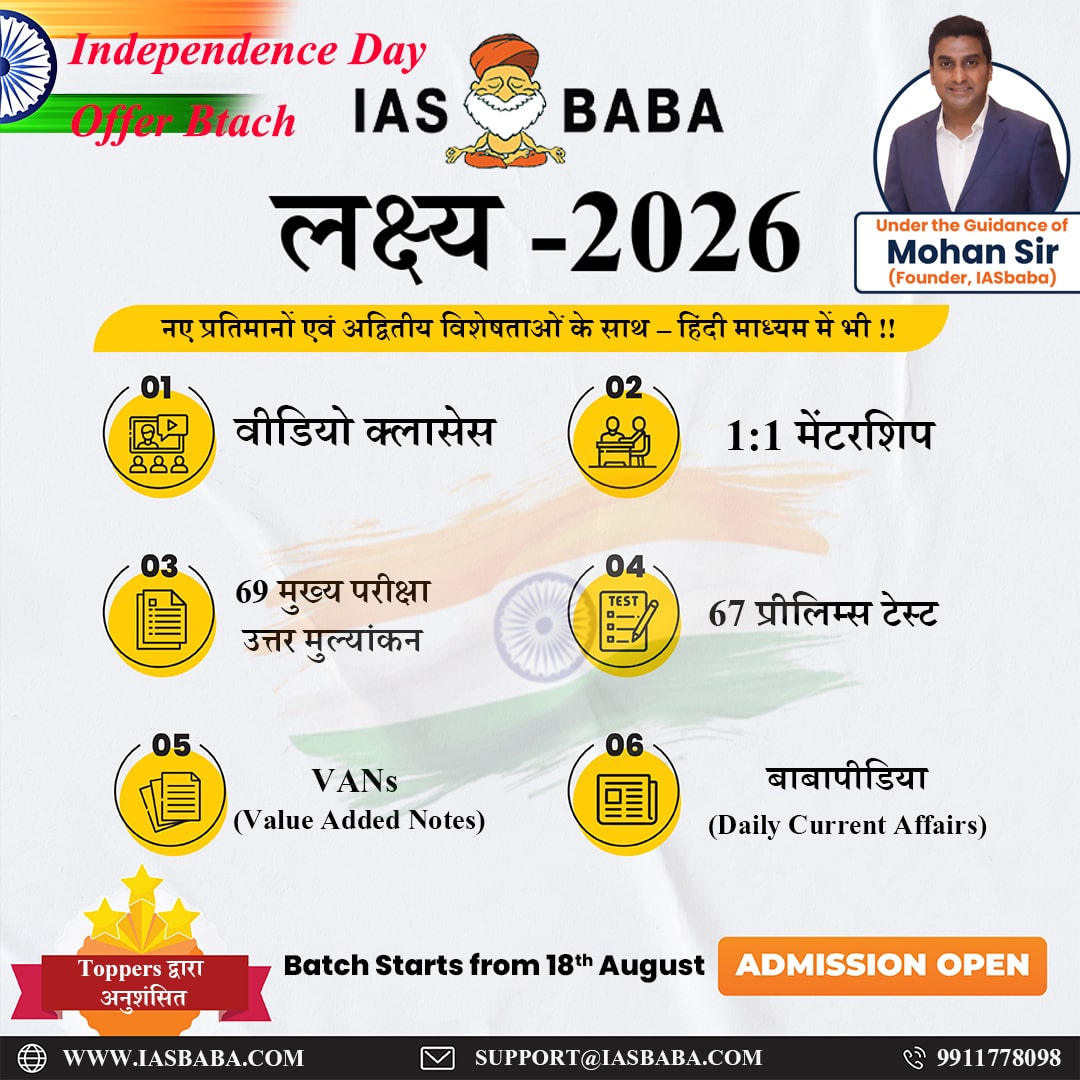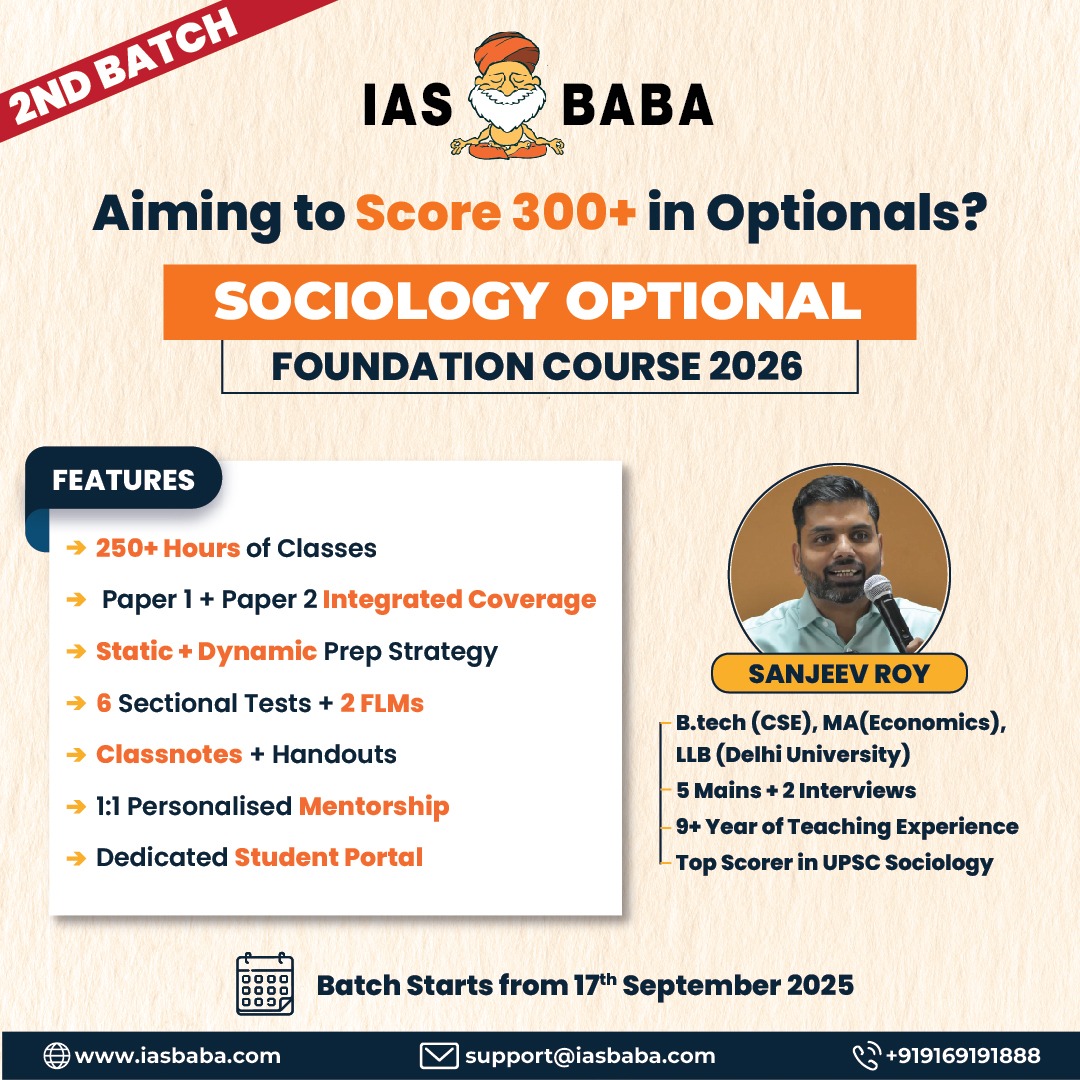IASbaba's Daily Current Affairs Analysis
Archives
(PRELIMS & MAINS Focus)
Syllabus:
- Prelims & Mains – POLITY
Context: Recently, the Union Ministry of Panchayati Raj released the Panchayat Devolution Index , which is based on a study conducted by the Indian Institute of Public Administration (IIPA).
Background: –
- The index was last published in 2014, and over the past decade, the national average score has increased from 39.92 to 43.89.
Key takeaways
- As of 2024, India has 2.62 lakh panchayats, an increase from 2.48 lakh in 2013-14. Uttar Pradesh, Maharashtra, and Madhya Pradesh recorded the highest number of panchayats in both 2013-14 and 2024.
- The IIPA studied 172 panchayats across 68 districts in India to assess the performance of the panchayat system based on six parameters: framework, functions, finances, functionaries, capacity building, and accountability. Using this data, the IIPA developed the Panchayat Devolution Index.
- The index scores states on a scale of 0 to 100. Karnataka, Kerala, and Tamil Nadu ranked highest on the index, while Uttar Pradesh and Bihar showed the most significant improvement.
- According to the latest index, Manipur, Arunachal Pradesh, and Jharkhand are the lowest-scoring states.
- Notably, in 2013-14, Maharashtra, Kerala, Karnataka, Tamil Nadu and Chhattisgarh got the top scores.
- Women representation: While most states have a 50% reservation quota for women in panchayats, seven states and union territories fall below this threshold.
- Odisha has the highest proportion of women among panchayat representatives at 61.51%, followed by Himachal Pradesh at 57.5% and Tamil Nadu at 57.32%.
- Uttar Pradesh has the lowest proportion of women representatives at 33.33%, as its regulations allow only a one-third reservation for women.
- Nationally, the average proportion of women representatives is 46.44%, a slight increase from 45.9% in 2013-14.
- While there is no formal reservation for SCs, STs, and OBCs, specific states have shown notable representation of these groups in panchayats.
- Punjab has the highest proportion of SC representatives at 36.34%.
- Chhattisgarh has the highest share of ST representatives at 41.04%.
- Bihar has the highest representation of OBCs at 39.02%.
- In comparison, the national average representation for these groups is 18.03% for SCs, 16.22% for STs, and 19.15% for OBCs.
Source: Indian Express
Syllabus:
- Prelims – SCIENCE & TECHNOLOGY
Context: Black plastic made headlines after a study claimed that the material contained toxic flame retardants, which could be leaching into food at hazardous levels. However, it was recently found that the study had miscalculated the levels of one of the toxic chemicals, leading the researchers to issue a correction.
Background: –
- Black plastic is often made from recycled electronic waste such as computers, TVs, and appliances. The issue is that these electronics typically contain substances such as the flame retardant bromine; antimony; and heavy metals such as lead, cadmium, and mercury.
Key takeaways
- Black plastic refers to plastics dyed with carbon black pigments, commonly used in packaging, electronics, automotive parts, and household goods.
- It is primarily made from recycled plastic but is difficult to recycle due to the presence of toxic chemicals and detection issues in recycling facilities.
Challenges in Recycling
- Black plastic is not easily detected by conventional sorting machines in Material Recovery Facilities (MRFs).
- Since most recycling systems use near-infrared (NIR) sensors, black plastic absorbs infrared light, making it invisible for sorting and leading to landfill disposal.
Presence of Toxic Additives
- Often contains hazardous chemicals like brominated flame retardants, heavy metals, and persistent organic pollutants (POPs).
- These chemicals leach into soil and water, causing health risks and environmental pollution.
Contribution to Microplastic Pollution
- When black plastic degrades, it breaks into microplastics, contaminating water bodies, soil, and even entering the food chain.
- Microplastics impact marine life and pose a human health hazard when ingested through food or water.
Link to E-Waste Pollution
- Black plastic is commonly sourced from e-waste, including discarded electronic casings, cables, and appliances.
- Improper disposal of e-waste black plastic releases hazardous chemicals, contributing to air and water pollution.
Landfill and Incineration Issues
- Due to low recycling rates, black plastic ends up in landfills or incinerators, releasing toxic fumes such as dioxins and furans, known carcinogens and endocrine disruptors.
Source: Indian Express
Syllabus:
- Prelims &Mains – HISTORY
Context: The Battle of Karnal, on February 24, 1739, saw Persian emperor Nadir Shah handing a crushing defeat to the forces of Mughal emperor Muhammad Shah Rangila.
Background:
- The army of Nadir Shah, founder of the Afsharid dynasty of Iran, defeated the Mughal forces in under three hours. The Shah of Iran subsequently captured and sacked Delhi, the Mughal capital, and emptied the royal treasury, taking home the fabled Peacock Throne and the Koh-i-noor diamond embedded on it.
Key takeaways
- The decline of the once-mighty Mughal Empire is attributed to structural weaknesses, rather than merely the incompetence of later emperors.
- Excessive Tax Burden on Peasantry
- Historian Irfan Habib argues that heavy taxation led to peasant revolts, which forced the empire to further increase taxes to fund military campaigns, creating a vicious cycle of economic distress. (The Agrarian System of Mughal India, 1963)
- Expansion of the Mughal Nobility
- M. Athar Ali highlights how an overgrown nobility in the late 17th century led to corruption, infighting, and inefficiency due to a shortage of lucrative jagirs (land revenue assignments). (The Mughal Nobility under Aurangzeb, 1966)
- Religious Alienation under Aurangzeb
- Historians like Jadunath Sarkar argue that Aurangzeb’s oppressive religious policies alienated Hindus and other minorities, leading to internal discontent and rebellions.
Nadir Shah’s invasion
- By the time of Aurangzeb, the Empire faced constant challenges, whether they be from the Marathas in the south, Ahoms in the east, or the Jats, Raputs, Bundelas, and Sikhs in the north and west. These challengers were not only taking territory but straining the Mughal treasury in the process.
- The invasion of Nadir Shah would be the single-greatest challenge that the Mughal Empire would face till that date. A military genius who some historians would later refer to as the “Napoleon of Persia”, Nadir Shah took over power in Iran after deposing the reigning Safavid dynasty.
- After conquering Kandahar in 1738, Nadir Shah set his sights on India. He crossed into the subcontinent through the famed Khyber pass — the route taken by previous invaders from the west, from Alexander to Timur.
- The two armies would meet in Karnal (present-day Haryana), some 125 km away from the capital.
The battle & beyond
- The Mughal army was 300,000-strong, boasting more than 2,000 war elephants and 3,000 cannons. Nadir Shah’s army was much smaller, only 55,000 strong. But it was more disciplined, significantly experienced, and boasted modern tactics and weaponry. This, along with Nadir Shah’s own genius, proved to be no match for the Mughals.
- The Mughal army was routed in under three hours, and Muhammad Shah was subsequently captured. The Persians then marched to Delhi where they plundered the royal treasure, and massacred thousands in one of the most violent episodes in Delhi’s history.
- Nadir Shah eventually handed Rangila his territories back but he left Delhi with what was the accumulated wealth of eight generations of imperial Mughal conquest.
- Over the next hundred-odd years, the Mughal Empire ceded more and more territory, till the British finally ended Mughal rule once and for all in 1857.
Source: Indian Express
Syllabus:
- Prelims & Mains – CURRENT EVENT
Context: India’s textile industry is among the largest in the world. Despite its scale, India lags behind countries like China, Vietnam, and Bangladesh in textile exports.
Background: –
- Sustainability is set to pose a major challenge for India’s textile industry, as global brands and markets tighten compliance norms. These include higher renewable energy use, water and material recycling, and stricter sourcing and traceability requirements.
Key takeaways
- Cotton cultivation provides livelihood to nearly 60 lakh farmers, mainly in Gujarat, Maharashtra, and Telangana.
- The entire cotton textile value chain—from processing raw fibre and spinning yarn to weaving fabric, dyeing, and stitching—employs over 4.5 crore people.
- Although cotton dominates fibre consumption in India, the textile industry also utilizes wool, jute, and man-made fibres (MMF).
- India is the second-largest producer of MMF, with Reliance Industries Ltd leading in polyester fibre and Aditya Birla Group’s Grasim Industries Ltd being the only domestic producer of viscose fibre.
- Around 80% of India’s textile value chain is concentrated in MSME clusters, each specializing in different segments:
- Bhiwandi, Maharashtra – Fabric production
- Tiruppur, Tamil Nadu – T-shirts and undergarments
- Surat, Gujarat – Polyester and nylon fabric
- Ludhiana, Punjab – Woolen garments
Growth, exports in the red
- The textile and apparel industry contributes 13% to industrial production, 12% to exports, and nearly 2% to GDP. However, manufacturing in the textile and apparel industry has slightly contracted over the past 10 years, according to the Index of Industrial Production (IIP).
- The economic downturn after the Covid pandemic, caused by a combination of global and domestic headwinds, has taken a severe toll on the MSME clusters, especially in Tamil Nadu.
- Although India maintains a trade surplus in textiles and apparel, export growth has remained sluggish in recent years.
Challenges in Export Competitiveness
- India faces stiff competition from China, Vietnam, and Bangladesh, primarily due to higher production costs and fragmented supply chains.
- Lack of Vertical Integration
- India’s cotton supply chain is scattered across multiple states, leading to higher logistical costs and inefficiencies.
- In contrast, China and Vietnam have vertically integrated ‘fibre-to-fashion’ firms, enabling cost-effective production, consistent quality, and agility in adapting to market trends.
- Regulatory & Trade Barriers
- Complex customs procedures in India make textile exports more expensive and time-consuming.
- Competitor nations benefit from simpler regulatory frameworks and Free Trade Agreements (FTAs), which provide them with a price advantage in global markets.
- High Raw Material Costs in MMF Sector
- The MMF industry in India suffers from higher raw material costs, further reducing its competitiveness.
- Quality Control Orders (QCOs) restrict imports of polyester and viscose fibres, forcing domestic yarn makers to rely on more expensive local alternatives.
Source: Indian Express
Syllabus:
- Prelims – SCIENCE & TECHNOLOGY
Context: Incidents of sudden hair loss in Maharashtra’s Buldhana district, which made national headlines, are linked to high selenium content found in wheat from Punjab and Haryana supplied by local ration shops, as per a medical expert’s report.
Background: –
- The cases of sudden hair loss, or ‘acute onset alopecia totalis’, were reported in 279 persons in 18 villages of Buldhana between December 2024 and January this year, prompting authorities to order a probe into the matter.
Key takeaways
- Selenium (Se) is a nonmetal element.
- It naturally occurs in various forms, including a gray metallic form known for its photoconductive (conducts electricity when exposed to light) properties, making it useful in photocells and light meters.
- Selenium is primarily obtained as a byproduct of copper refining and is utilized in glassmaking, pigments, and electronics.
- Biologically, it is an essential trace mineral vital for functions such as thyroid hormone metabolism, DNA synthesis, and protection against oxidative damage and infection.
- Selenium is a mineral found in the soil and naturally appears in water and some foods. Dietary sources rich in selenium include Brazil nuts, fish, poultry, and grains.
- While necessary in small amounts, excessive selenium intake can lead to toxicity.
Source: The Hindu
Practice MCQs
Q1.) With reference to the Battle of Karnal (1739), consider the following statements:
- Nadir Shah invaded India after capturing Kandahar in 1738.
- The Mughal army was significantly smaller than Nadir Shah’s army.
- The outcome of the battle led to the weakening of the Mughal treasury and further decline of the empire.
Which of the statements given above is/are correct?
(a) 1 and 2 only
(b) 2 and 3 only
(c) 1 and 3 only
(d) 1, 2, and 3
Q2.) The Panchayat Devolution Index is developed based on which of the following parameters?
- Framework
- Functions
- Finances
- Functionaries
- Capacity Building
- Accountability
Select the correct answer using the codes given below:
(a) 1, 2, 3, and 4 only
(b) 1, 2, 3, 5, and 6 only
(c) 1, 2, 3, 4, and 5 only
(d) 1, 2, 3, 4, 5, and 6
Q3.) Consider the following statements regarding Selenium:
- Selenium is a nonmetal element that naturally occurs in various forms, including a photoconductive metallic form.
- It is primarily obtained as a byproduct of iron refining.
- Excessive intake of selenium can lead to toxicity in humans.
Which of the statements given above is/are correct?
(a) 1 and 2 only
(b) 2 and 3 only
(c) 1 and 3 only
(d) 1, 2, and 3
Comment the answers to the above questions in the comment section below!!
ANSWERS FOR ’ Today’s – Daily Practice MCQs’ will be updated along with tomorrow’s Daily Current Affairs
ANSWERS FOR 24th February – Daily Practice MCQs
Q.1) – a
Q.2) – a
Q.3) – a














